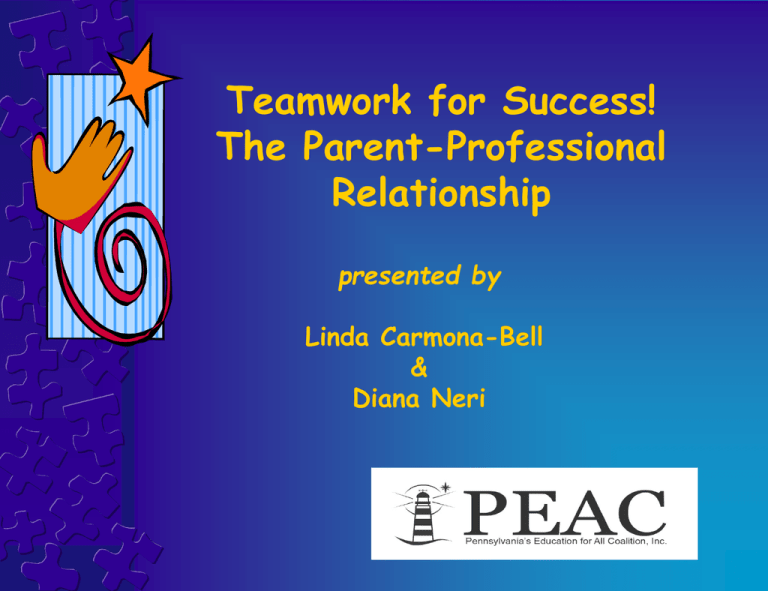Webinar PowerPoint
advertisement

Teamwork for Success! The Parent-Professional Relationship presented by Linda Carmona-Bell & Diana Neri Goals and Expectations • To understand “what is collaboration and a collaborative team environment” • To understand the components of working effectively in a collaborative team • To increase collaboration skills that will foster positive family-school communication 2 What is Collaboration? Think about a few words that you associate with “collaboration.” Activity • DIRECTIONS: • Think about a situation when you had to collaborate. What did you do right or what did you do that you thought was wrong? • Think about your actions. • Hold onto this memory for later in the training. 4 Why Collaborate? Why Collaborate? • It is through the work of collaborative teams that students with disabilities are fully included in typical activities and routines and beyond to extracurricular activities. • It is not always easy. • Working through differences and finding areas of agreement and compromise are necessary to meet the ultimate goal of inclusion and meaningful participation for 6 the student. Effective Inclusion involves good collaboration and communication among teachers, family members, administrators, paraeducators, and community resources. The Collaborative Team 7 So… What is a Collaborative Team? “For the Birds” www.youtube.com/watch?v=yJzQiemCIuY 8 What is a Collaborative Team? • A collaborative team has a common language • Sometimes collaboration can be mean-spirited and ineffective. We want our teams to be positive and supportive. 9 Finish this sentence… A Collaborative Team is not… Jot down your thoughts in the CHAT area! 10 A Collaboratve Team is not… • A bully pulpit • A dictatorship-monopolizing conversation • A close-minded forum without hearing and listening to one another • Where multiple people speak at the 11 same time Guided Viewing As you view the video, make note of specific examples of collaboration. Also, note ways you have used these skills in working with your team. 12 • Everyone on the team has a valuable contribution to make to the team and to support your child. • The collaborative team is often the IEP team, and should include teachers, family members, administrators, related service and support personnel, paraeducators, community resources, and, of course, the student. 13 The Importance of Team Composition • Who should be on the team? • How many members are there on the team? • Is anyone missing from the team? Core Team Members Expanded Team Members Consulting Team Members 14 What is my role on this team? Team Specific Roles should: • Reflect the strengths and talents of the individual member • Vary to share responsibilities • Be identified and filled • Be voluntary 15 Think about… What strengths do you bring to the team? 16 Collaborative Teaming is a transdisciplinary approach to team functioning that is. . . • based on mutual goals within a framework of similar beliefs • requires parity among participants • depends on shared responsibility for participation and decision making • requires shared responsibility for outcomes • requires that participants share their resources • reflects voluntary relationships 17 Characteristics of Collaboration 18 Collaborative Teaming • The most important feature of a collaborative team is shared decisionmaking as they work toward a “common goal”. • Establishing a “common goal” is central to successfully meeting the needs of a student. • People working together to achieve a common goal or goals. 19 Some Team Conflict is to be Expected… 20 Conflict: “The struggle that occurs when individuals, interdependent with others, perceive that those others are interfering with their goal attainment.” (Friend & Cook)21 How Do You Collaborate? How Do You Collaborate? • Acknowledge differences • Open discussion of each person’s positions • Compromise 23 One Strategy to Collaborate 1. Clarify the purpose of all gathering together. 2. What does the student need (academic, environmental, etc…)? Just focus on the facts. 3. Identify the current options. 4. Brainstorm (no judgment on suggestions). 5. Review all options to see what meets the student’s needs (see #2). 6. Choose the best fit for the student and family. 24 What Can Go Wrong? • Alternatives are not considered carefully. • Minority opinions are silenced. • Disagreements among members. 25 What Can Go Right? An effective team can... • • • • • • Stimulate team interest in the student Allow for new instructional ideas. Lead to creative problem solving. Improve decision making skills. Build stronger team bonds. Create ownership and commitment for 26 decisions. Collaboration It’s all about communication 27 Keys to Effective Communication Active Listening Getting beyond egos Empathizing and… 28 Ongoing Communication If families are to be involved as true partners in their children's education, it is important to provide on-going opportunities to hear their concerns and comments as well as providing them information. Moles, 1996 29 Effective communications builds TRUST among Team Members. 30 Think about how your team has established trust. 31 Activity • Step 1: Recall the personal situation from the beginning of this session. • Step 2: Determine what you like about what you did. • Step 3: Determine what you could have done differently. 32 “We will surely get to our destination if we join hands.” Kyi, Aung San Suu Human Rights Activist 33 ANY QUESTIONS 34 34

